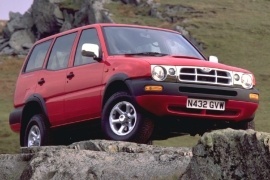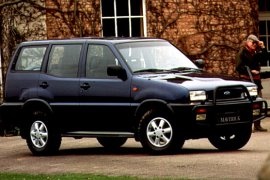
FORD Maverick LWB
Generations Timeline, Specs and Pictures

Ford joined forces with Nissan and offered the Maverick SUV in two body styles for the European market.
The Maverick/Terrano II duo was built in Spain, at Nissan’s plant, and it appeared on the market in 1993. Both partners decided to upgrade their models starting with 1996. Ford enhanced its model with its new design language and offered new trims for the interior. A seven-seat option was available for the long-wheelbase version.
On the outside, the 1996 Maverick featured new, dual headlights at the front. The silver plastic grille resembled the one from the Ranger pickup. Ford installed bigger wheel-fender moldings around the wheel-wells; hence the previous model was criticized for its slim ones. There was a new design available for its light-alloy-wheels.
Another good upgrade was on the technical side, where the engines were updated. Even though it didn’t receive the 3.0-liter unit like the Terrano II, it went well with the 2.7-liter turbodiesel, upgraded to 125 hp from the pre-facelifted variant, which only had 101 hp. The torque was increased to 278 Nm (205 lb-ft). The 2.4-liter gasoline unit lost some power and, since 1996, had only 118 hp instead of 124 as before.
The 4x4 transmission system was via a transfer-case with high and low gear. Ford didn’t offer a center differential or locking differentials. The Maverick had a front-wheel independent suspension while the rear axle was rigid-type with coil springs and an anti-roll bar.

Ford and Nissan joined forced to develop a new SUV for the European market, resulting in the Maverick-Terrano II duo, both available with three and five-door versions.
The American brand chose the Maverick name while Nissan continued with the Terrano II name as a successor for the first-generation Terrano. While basically, both vehicles were technically the same, the marketing strategy was different, and Ford decided to use other package options for its models.
With its soft corners and shaved angles, the Maverick confirmed that the wedge-shapes era was gone even for the 4x4 vehicles. However, there were some reminiscences on the squared headlights and rectangular turn-signals and fog-lights mounted on the front bumper. But the new design era was noticeable on the sides, where the ascending beltline looked curved, like a soft step on the rear doors, above the quarter panels.
Ford installed offered the Maverick with five or seven-seat options, with jump-seats in the trunk area. With the second and third rows folded down, the Maverick offered a 1900 liter (67 cu-ft) trunk size, while with all seven seats installed, it could barely provide room for a few sandwiches.
The vehicle was built on a ladder-chassis, with a front independent suspension and a five-link rear axle. It was powered either by a 2.4-liter gasoline engine or a 2.7-liter turbodiesel. All versions were part-time 4x4 with a low-range gear, and the standard transmission was a 5-speed manual. Depending on the market, an option for a 4-speed automatic was on the options list.























































